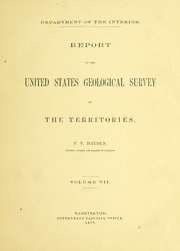Table Of ContentTHE UNIVERSITY
OF ILLINOIS
LIBRARY
From the collection of
\
Julius Doerner, Chicago
Purchased, 1918,
cl. 5 57,3
v.?
Digitized by the Internet Archive
in 2015
https://archive.org/details/annualreportofpr7187tran
DEPARTMENT OF THE INTERIOR.
REPO II T
OF THE
UNITED STATES GEOLOGICAL SURVEY
OK
THE TERRITORIES.
F. V. IIAYDEN,
UNITED STATES GEOLOGIST-IN-CIIARGE.
VOEUME VII.
WASHINGTON:
GOVERNMENT PRINTING OFFICE.
1878.
I
LETTER TO THE SECRETARY.
Office of the United States Geological and
Geographical Survey of the Territories,
Washington, D. C, January 1, 1878.
Sir : I have the honor to transmit herewith, for your approval and for
publication, the Seventh Volume of the Final Reports of the Survey under
my charge.
The work consists of a Report on the Tertiary Flora of the West, *by
Prof. Leo Lesquereux, of Columbus, Ohio, being Part II of ''Contributions
to the Fossil Flora, of the Western Territories" — Part I being "The Cre-
taceous Flora", by the same distinguished author, whose long-continued
studies in palaeo-botany have placed the subject upon a firm and enduring
basis. Part I formed Vol. VI of this series of Final Reports, and the
present Part constitutes Vol. VII.
The circumstances which led to the preparation of this work may be
briefly reviewed.
When the geological investigation of the Lignitic formations of the
West had reached a certain point, the conclusions derived from such studies
were discussed by certain geologists who dissented from the views then
expressed respecting the age of these strata. It consequently became
desirable, in order to the solution of the questions involved, to elaborate
further, and with the greatest care, all available material bearing upon this
interesting problem. To this end, I desired Prof. Joseph Leidy, Prof. E.
D. Cope, Mr. F. 13. Meek, and Prof. Leo Lesquereux, to present in detail
all the evidence they could secure in their respective specialties of Extinct
Vcrtebrata, Extinct Invcrtebrata, and Fossil Flora, bearing on the disputed
age of these formations, to decide, if possible, whether the strata in question
are Cretaceous or Tertiary. The various reports which these gentlemen
have furnished testify with what zeal, ability, and success these instructions
have been carried out.
ui
IV LETTER TO THE SECRETARY.
If objection is made to the use of the term "Lignitic'' Group, I would
say that, in this work, it is restricted to a series of coal-bearing strata lying
above the Fox Hills Group, or Upper Cretaceous, and these are embraced
in the divisions Laramie and Fort Union Groups. It is well known that
there are in various parts of the West, especially along the fortieth parallel
and south westward, very thick beds of coal in the various divisions of the
Cretaceous, extending down even into the Upper Jurassic. Had this not
been the case, the more general term Lignitic would have been retained by
this Survey, in preference to any other.
As far back as 1859 it was' my belief, founded on what appeared to be
sufficient evidence, that the sequence between the well-characterized Creta-
ceous strata and those of the Lignitic Group, as defined at that time, was
continuous, and that the chasm which was supposed to exist between the
Cretaceous and the Tertiary epoch would be found to be bridged over. This
belief was not based on strictly pakeontological evidence, for no well-marked
Cretaceous fossils were then known to pass up into the Lignitic or brackish
beds. But the physical conditions under which the sediments of the upper
strata of the Fox Hills Group were deposited indicated a gradual change,
-from deep, quiet marine seas to shallow waters, which became at length
brackish and finally entirely fresh waters, during which time the purely
marine invertebrate fauna perished, a brackish and purely fresh-water fauna
taking its place. This condition of the Lignitic Group covered a vast area
in the Northwest, extending far southward, along the eastern slope of the
Rocky Mountains, to Denver, Colorado. As we proceed southward and
westward from the Missouri River, the brackish beds increase in thickness
until along the fortieth parallel they become three thousand feet or more,
indicating, so far as can be determined, no break in the sequence from the
Fox Hills Group to the purely fresh-water strata of the Wahsatch Group.
Dr. C. A. White, Paleontologist to the Survey under my charge, has
made a critical examination of these formations during the past season, and
lie says that his investigations have fully confirmed the views expressed by
me some years ago, and indicated by the palasontological studies of Mr. Meek,
that the Fort Union beds of the Upper Missouri River are the equivalent of
the Lignitic formation as it exists along the base of the Rocky Mountains in
Colorado. He also testifies to the equivalency of the latter with the Bitter
Creek series west of the Rocky Mountains. These views of Dr. White are con-

